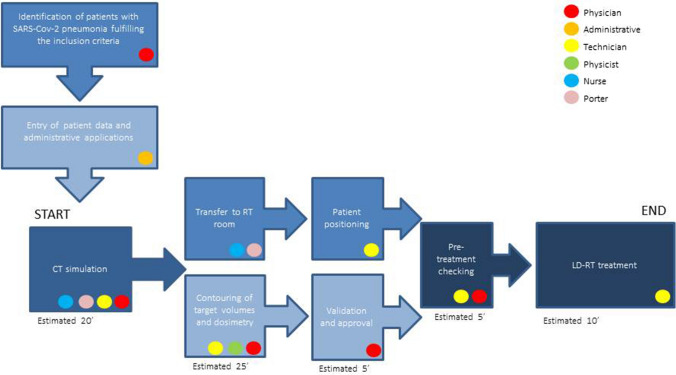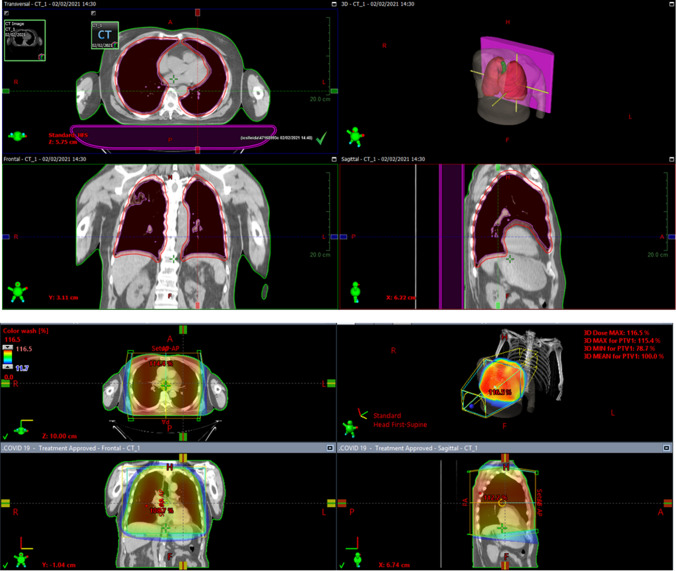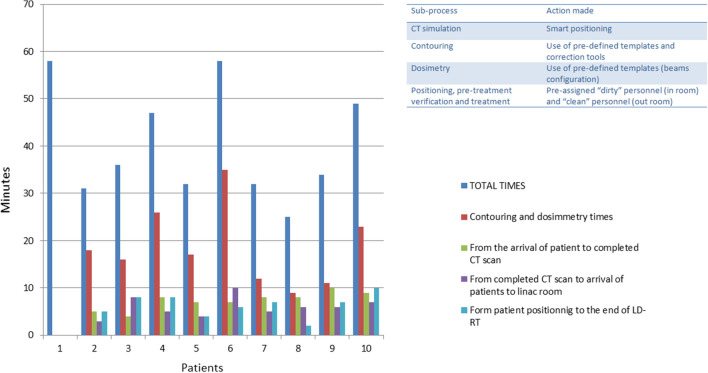Abstract
Background
The use of low dose radiotherapy (LD-RT) for the treatment of COVID-19 pneumonia is supported by biological rationale for its immunomodulatory effect. Some institutions have started to treat these patients showing encouraging results. To shorten procedure times is crucial for the comfort of symptomatic patients receiving respiratory support and to optimize institutional facilities.
Patients and methods
At our institution, LD-RT is offered to hospitalized patients with COVID-19 pneumonia and signs of early cytokine-released syndrome on behalf of a multicenter study. We designed a coordinated process flow starting from the patient transfer to the simulation CT-scan (first-step), to the end of the LD-RT treatment (last step). The times spent on each step of the process flow were evaluated.
Results
Mean age of treated patients was 83 (72–91) years-old. The timing parameters of the first 10 consecutive patients were analyzed. Except for the first (dummy run), patients were managed from the first to the last step in a median of 38 min (25–58, SD 10.67). The most time-consuming sub-process was the contouring of the treatment volumes and dosimetry.
Conclusions
LD-RT is not only an encouraging option for COVID-19 pneumonia patients, but a convenient and feasible procedure if performed in a coordinated way by reducing procedure times.
Keywords: Low-dose radiotherapy, COVID-19, Pneumonia, Procedure times, Workflow
Introduction
At present there are many clinical trials on-going to assess the efficacy of different treatments for COVID-19 disease. Low dose radiotherapy (LD-RT) has emerged as a promising option by reducing the inflammatory response in the lungs caused by SARS-CoV-2 pneumonia. As an institution, we are participating in the on-going multicenter clinical study IPACOVID (ClinicalTrials.gov Identifier: NCT04380818) which is evaluating the efficacy of LD-RT as an adjunctive treatment in interstitial pneumonia in patients with COVID-19, to prevent patient progression to a critical state.
Since the start of the COVID-19 outbreak, few prospective cohort studies of patients treated with LD-RT have been published. Results are encouraging though, and improvements in imaging and biomarkers are reported, leading to hospital discharges in less than 2 weeks and with no significant acute toxicity [1–3]. In spite of these results, a recent randomized doubled-blind study performed with critically ill patients requiring mechanical ventilation, has failed to demonstrate improvements in clinical outcomes. However, the on-going multicenter study IPACOVID is evaluating the efficacy of LDRT in patients with SARS-CoV-2 pneumonia with signs of early cytokine-released syndrome, which would be a more favorable clinical population. Results from the current clinical study have not been yet published [4].
While the main role of these studies is to evaluate the efficacy and safety of LD-RT, the feasibility and convenience of the radiotherapy procedures in this context is also critical. In April 2020, close to the start of the pandemic outbreak, the Spanish Society of Radiation Oncology in collaboration with the Spanish Ministry of Health wrote a document guiding the management of cancer patients suffering from COVID-19 [5]. Some of these logistical recommendations were to design a specific waiting room if possible and to locate these patients at the end of the day to ensure a low flow of patients and personnel.
However, when treating non oncological COVID-19 patients, there are some other considerations to be taken into account. Many of these patients are elderly and need rest while receiving respiratory support. Therefore, shortening the time spent on mobilizations and transfers is a priority to avoid a clinical worsening. As recommended by our colleagues from Internal Medicine, who are experts in the management of COVID-19 disease, we have prioritized avoiding unnecessary displacements and to ensure respiratory stability for the patient. As a consequence, we developed some measures focusing on shortening, as far as possible, the stay of patients in our Department.
Reducing waiting times during the LD-RT process needs close collaboration with the different medical departments that are involved in the management of these patients. At our institution, Internal Medicine, Radiology, Radiation Physics and the Radiation Oncology Departments are implied in the management of COVID-19 pneumonia-related patients that would benefit from a LD-RT.
We designed a coordinated workflow between these departments aiming to minimize patient waiting times, improve convenience and optimize health-care facilities at our institution.
Patients and methods
LD-RT is at present being offered to hospitalized patients with COVID-19 pneumonia on behalf of the on-going multicenter study IPACOVID (ClinicalTrials.gov identifier NCT04380818) approved by the local Ethics Committee. Clinical details are depicted in the protocol. All patients had a proven SARS-CoV-2 infection and related pneumonia diagnosed by imaging, and also fit the inclusion criteria for signs of early cytokine-released syndrome according to the study.
The timing starting from the entrance of the patient into the CT room for simulation to the delivery of the planned LD-RT was recorded and evaluated descriptively.
The workflow
All patients were hospitalized and supported by the Internal Medicine Department, where patients were proposed for the study and signed the consent form. The next step was to immediately contact the Radiation Oncology Department. Then, the workflow for LD-RT started and CT planning was scheduled in a safe time slot reserved for COVID-19 patients.
To optimize the workflow between the Internal Medicine, Radiology, Radiation Physics and Radiation Oncology Departments, one person was assigned to be in charge of each unit. According to our clinical experience in oncologic diseases, estimated times for each process/sub-process were about 65 min in total. As the main concern of Internal Medicine Department was the time the patient was out of the hospitalization ward, we developed a theoretical framework. It has been based on the standard clinical practice of Radiation Therapy Departments in our country and agreed after a survey within the clinical and technical staff at our institution. A description of each process, the person in charge and estimated duration is shown in Fig. 1.
Fig. 1.
Description of each process, person in charge and estimated times. RT radiotherapy, LD-RT low-dose radiotherapy
The contouring and dosimetry sub-process
After the acquisition of the CT-scan, the critical structures were created for dose calculation and positioning on the treatment facility (lungs, trachea, carina and bronchia). A template with those structures was pre-defined. The lung structure was drawn using automatic tools including all lung tissue. Manual corrections of these volumes were performed depending on the extension of the pneumonia. The trachea was manually drawn from the lung apex to the bronchia. This structure was used as a reference for patient positioning. Post-processing tools were used when needed.
The PTV was created as an expansion of the lung structure with an additional margin (of 5 mm in all axes except for the cranio-caudal direction where margins were of 10 mm) as indicated per protocol (Fig. 2). Radiotherapy treatment was planned using an isocentric technique with two opposing (AP/PA) 6 MV photon beams. To simplify the dosimetric sub-process, a template was created with the setup field and certain fixed parameters (such as beams configuration), that was adjusted for each patient. The treatment volume was then fitted by adding a MLC with a margin of 10 mm. The plan was normalized to the average dose and field weights were also adjusted.
Fig. 2.
a Treatment volumes in a patient with COVID-19 pneumonia. b LD-RT dosimetry of the same patient
The treatment
The spaces were zoned to define “clean” and “dirty” areas. The same two technicians that wore personal protective equipment (PPE) to perform the CT-simulation (“dirty” personnel) were the same that positioned the patient in-room. A third technician and a Radiation Oncology physician (“clean” personnel) were managing the console. An Internal Medicine Physician (“dirty” personnel) was also present in case patients had respiratory distress. A zone located at more than 2 m from the console was defined to place the “dirty” personnel while performing the treatment.
Results
The first ten patients were treated from 1st Feb 2021 to 24th Feb 2021. Median age was 83 (72–91) years-old.
The whole process and sub-process times were recorded from all patients. Except for the first patient, where the time spent was 58 min, the average treatment times were less than initially estimated. Patients were managed from the simulation CT-scan (first-step) to the end of the LD-RT treatment (last step) in a median of 38 min (25–58, SD 10.67).
As shown in Fig. 3, the most critical sub-process was the contouring of volumes and dosimetry steps. After the dummy-run for the first patient, the times spent in the delineating and dosimetry sub-process were progressively reduced. In addition, we learned that the use of the ‘pelvis’ greyscale was more appropriate than the usual lung contouring presents. Nevertheless, we experienced an unexpected computer network crash that affected the whole institution delaying the download of CT images and contouring and dosimetry sub-process in the sixth patient.
Fig. 3.
Whole process and sub-process times. Table: actions made to improve times in each sub-process
None of the personnel involved in the treatment of these patients has been infected by SARS-Cov-2.
Discussion
In the context of an infectious disease such as COVID-19 there are three main points we consider to be crucial: first, time efficiency; second, patient convenience and third, patient safety during the process to avoid contagion among health personnel. So, we describe an optimized and convenient workflow based on the collaboration of four medical Departments at the same institution.
To achieve the first point it is necessary to limit the extent of non‐value‐adding activities and to appoint a person in charge of each sub process to improve throughput [6]. In addition, radiotherapy is a modality of treatment that needs several steps and where clinical practice workflows should be highly standardized [7]. So, we can state that the time reduction we achieved in the contouring process has primarily been a consequence of the acquired experience in automatic contouring and the use of templates (for structure creation and beam configuration). The delimitation parameters that are usually used are inadequate due to the heterogeneous density of the lung tissue caused by pneumonia. Even though a manual correction is essential, this automation can greatly reduce the time spent in the contouring sub process. Similarly in our practice, treatment planning is being customized from a single template with two opposing beams. Dose distribution is calculated and optimized using the simulation CT, but with a basic configuration already predefined.
Shortening waiting times during the LD-RT process needs close collaboration between the different medical departments involved as mentioned before. We are proud that at our institution, the collaboration between Internal Medicine, Radiology, Radiation Physics and the Radiation Oncology Departments is successful throughout all the different tiers of health personnel implied.
It is important to note that our patients were elderly with a mean age of 83 years-old. It has been suggested that older patients would be enrolled in clinical trials for potential antiviral medications [8]. However, most of these hospitalized patients are close to a “therapeutic ceiling” and need a resting position to avoid worsening of COVID-19 respiratory symptoms [9]. So it is important to avoid unnecessary displacements and to give them the highest comfort. All patients have received the standard of care protocolized in our center, which consists in administration of dexamethasone, prophylactic enoxaparin and, tocilizumab in those patients with elevated CRP and IL-6, and/or remdesivir in patients with symptoms lesser than 7 days. It is important to highlight that all patients with respiratory distress have received respiratory support with a high-flow nasal cannula or non-invasive ventilation as an alternative to hospitalization in the Intensive Care Unit, associated with a worsening prognosis in this age group, especially when they undergo orotracheal intubation and mechanical ventilation.
Finally, it has recently been demonstrated that following preventive policies among health personnel COVID-19 infections can be avoided [10]. With agreement, we defined personnel protection levels and we took cleaning and disinfection actions to minimize the risk of contagion. Workers were divided into “clean” or “dirty” roles that permitted a continuous workflow of the different sub-processes that have taken place in a sliding or simultaneous way.
In conclusion, LD-RT is not only an encouraging option for COVID-19 pneumonia patients, but is also a convenient and safe procedure if performed in a coordinated way. To perform LD-RT in a short time is feasible when both the workflow and communication between departments is accurate.
Acknowledgements
We want to thank the technicians Maria Cagigós, Irene Riquer, Daniel José Lueza, Alexandre Palau and Jordi Fontova and nurses Esther Chiné and Oriol Torné for their dedication and collaboration.
The authors also want to thank Magda Font and Kathryn Gibson for their language support.
Declarations
Ethical approval
All procedures of the present study were in accordance with the ethical standards of the institution.
Informed consent
Informed consent was obtained from all individual participants included in the study.
Footnotes
Publisher's Note
Springer Nature remains neutral with regard to jurisdictional claims in published maps and institutional affiliations.
References
- 1.Hess CB, Nasti TH, Dhere VR, Kleber TJ, Switchenko JM, Buchwald ZS, et al. Immunomodulatory low-dose whole-lung radiation for patients with Coronavirus Disease 2019-related Pneumonia. Int J Radiat Oncol. 2021;109:867–879. doi: 10.1016/j.ijrobp.2020.12.011. [DOI] [PMC free article] [PubMed] [Google Scholar]
- 2.Hess CB, Buchwald ZS, Stokes W, Nasti TH, Switchenko JM, Weinberg BD, et al. Low-dose whole-lung radiation for COVID-19 pneumonia: planned day 7 interim analysis of a registered clinical trial. Cancer. 2020;126:5109–5113. doi: 10.1002/cncr.33130. [DOI] [PMC free article] [PubMed] [Google Scholar]
- 3.Moreno-Olmedo E, Suárez-Gironzini V, Pérez M, Filigheddu T, Mínguez C, Sanjuan-Sanjuan A, et al. COVID-19 pneumonia treated with ultra-low doses of radiotherapy (ULTRA-COVID study): a single institution report of two cases. Strahlentherapie und Onkol. 2021; 197:429-437. [DOI] [PMC free article] [PubMed]
- 4.Papachristofilou A, Finazzi T, Blum A, Zehnder T, Zellweger N, Lustenberger J, et al. Low-Dose Radiation Therapy for Severe COVID-19 Pneumonia: A Randomized Double-Blind Study. Int J Radiat Oncol. 2021; S0360-3016(21)00239-X. [DOI] [PMC free article] [PubMed]
- 5.Sociedad Espanola de Oncología Radioterápica. Recomendaciones para el manejo, prevención y control de COVID-19 en los servicios de oncología radioterápica. [Internet]. 2020. Last consulted 15 march 2021. Available from: https://www.mscbs.gob.es/profesionales/saludPublica/ccayes/alertasActual/nCovChina/documentos/COVID19 oncort.pdf
- 6.Oredsson S, Jonsson H, Rognes J, Lind L, Göransson KE, Ehrenberg A, et al. A systematic review of triage-related interventions to improve patient flow in emergency departments. Scand J Trauma Resusc Emerg Med. 2011;19:43. doi: 10.1186/1757-7241-19-43. [DOI] [PMC free article] [PubMed] [Google Scholar]
- 7.Halvorsen P, Gupta N, Rong Y. Clinical practice workflow in Radiation Oncology should be highly standardized. J Appl Clin Med Phys. 2019;20:6–9. doi: 10.1002/acm2.12555. [DOI] [PMC free article] [PubMed] [Google Scholar]
- 8.Nguyen NP, Vinh-Hung V, Baumert BG, Zamagni A, Arenas M, Motta M, et al. Older cancer patients during the COVID-19 epidemic: practice proposal of the International Geriatric Radiotherapy Group. Cancers (Basel) 2020;12:1287. doi: 10.3390/cancers12051287. [DOI] [PMC free article] [PubMed] [Google Scholar]
- 9.Nguyen NP, Arenas M, Vuong T, Zamagni A, Vinh-Hung V, de Bari B, et al. Low-dose whole-lung radiotherapy for older patients with Coronavirus Disease (Covid-19) Pneumonia: a phase I-II prospective non-randomized protocol by the International Geriatric Radiotherapy Group. Ach Clin Biomed Res. 2021;5(1):xx–xx. doi: 10.26502/achv.501700xx. [DOI] [Google Scholar]
- 10.Wei W, Zheng D, Lei Y, Wu S, Verma V, Liu Y, et al. Radiotherapy workflow and protection procedures during the Coronavirus Disease 2019 (COVID-19) outbreak: experience of the Hubei Cancer Hospital in Wuhan. China Radiother Oncol. 2020;148:203–210. doi: 10.1016/j.radonc.2020.03.029. [DOI] [PMC free article] [PubMed] [Google Scholar]





